|
Spring brought
us unseasonably warm weather in April and May with
a little dip in June. In early July we have
a steady stream of hot days so we find ourselves
sunning on the beach regularly. On Narbonne
Plage we are surprised to find a new restaurant located
directly on the sand in front of the surf. We
almost have to rub our eyes in disbelief as it is
an enormous confection of white tents and red umbrellas
- rather as we might imagine a mirage in the desert. It
is called La Voile Rouge, and we wasted no
time checking it out.
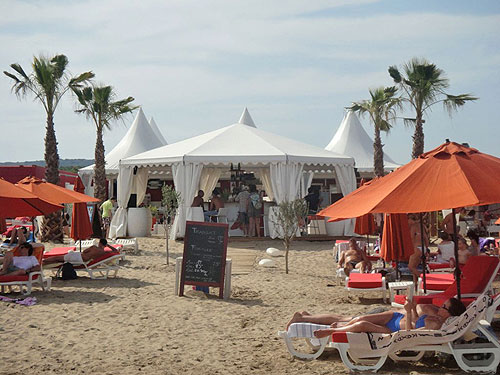
La
Voile Rouge at Narbonne Plage
Our first
visit we enjoy frosty glasses of chardonnay in
the bright sun, lounging on foamy chairs in full
view of the sea. Not bad, rather like a
swank Miami Beach. The second visit they
are still setting up the restaurant so we had
to come back a week later for a proper meal. We
return on a Monday evening to find the place
filled to the brim, every seat taken and looking
like it has been in business for years. My
entrée of oysters in a cream sauce is
lovely, and we all marvel at the towers of shellfish
that many customers are enjoying. The establishment
marks a milestone in Narbonne Plage's image,
bringing it up a notch from the regular cantines of moules
frites. In front of the resto there
are lounge chairs for rent for a tony 13 euros
a day. Take a look at the photo and you
may have to agree that la vie est belle, n'est-ce
pas?
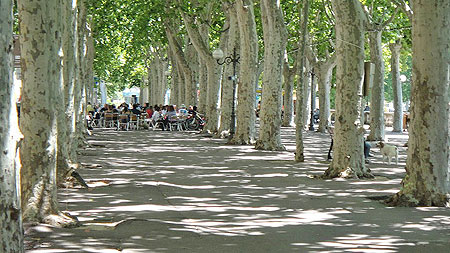 In
addition to our new beach place, we have
more great news to announce: in Narbonne city
center McDonald's fast food restaurant
has closed and left for good having been replaced
by a classic French brasserie called Le
Cristal! Gone are the big photos
of Big Mac, the endless swarm of ados,
and the accompanying poubelle. Now
we have a lovely sea of sparkling wine glasses
set on elegant tables and a crowd of varying
peoples all excitedly enjoying the graceful
cover of the tall platane trees
and the beautiful balustrades of les barques. Again
on a Monday - Narbonne is usually closed up
on Mondays - we visit Le Cristal with four
out-of-town visitors. The remarkably
well trained staff brings us crispy grilled
meats, luscious salads, chilled carafes of
wine and café gourmands. People
are eyeing each other, there is abundant laughter
in the air and the feeling is ubiquitous: Narbonne
is developing a more cosmopolitan atmosphere
with this new big-city type brasserie à la
Aix-en-Provence or even Paris. We started
the evening a little concerned that it was
too soon to test the new resto and ended up
walking away very pleased we had done so. In
addition to our new beach place, we have
more great news to announce: in Narbonne city
center McDonald's fast food restaurant
has closed and left for good having been replaced
by a classic French brasserie called Le
Cristal! Gone are the big photos
of Big Mac, the endless swarm of ados,
and the accompanying poubelle. Now
we have a lovely sea of sparkling wine glasses
set on elegant tables and a crowd of varying
peoples all excitedly enjoying the graceful
cover of the tall platane trees
and the beautiful balustrades of les barques. Again
on a Monday - Narbonne is usually closed up
on Mondays - we visit Le Cristal with four
out-of-town visitors. The remarkably
well trained staff brings us crispy grilled
meats, luscious salads, chilled carafes of
wine and café gourmands. People
are eyeing each other, there is abundant laughter
in the air and the feeling is ubiquitous: Narbonne
is developing a more cosmopolitan atmosphere
with this new big-city type brasserie à la
Aix-en-Provence or even Paris. We started
the evening a little concerned that it was
too soon to test the new resto and ended up
walking away very pleased we had done so.
Besides the
new restos we also have plenty of friendly barbecues
to enjoy. One of our signature dishes is
a round of brie or camembert put on the barbecue
still inside its wooden box. The top of
the cheese is sliced with an 'x' that is opened
and some pesto or eau de vie is sprinkled
inside. As the cheese melts, it absorbs
the ingredients sprinkled within and becomes
a delicious fondue that we dip bread into. In
La Clape, an enormous nature reserve next to
the beach, there are dozens of picnic spots nestled
in the trees where we bask outdoors undisturbed
while cooking a delicious lunch. Escape
to La Clape is particularly handy when the wind
is blowing too hard to sit on the beach – unless
you enjoy getting sand blasted. The shielded
picnic areas provide enough sun to get bronzed,
and we are mollified by the alternative to sand
and sea. Port La Nautique is also an idyllic
spot for outdoor cooking and gatherings. We
attend a party for a large group of expats there,
all of us joined by our French teacher who organizes
the barbecue. The warm weather brings people
together, and we are happy to be living here,
especially when the rest of France is experiencing
a lot of unseasonal rain and lower-than-normal
temperatures this summer. Even the Côte
d’Azur has had more than its share of rain
this year.
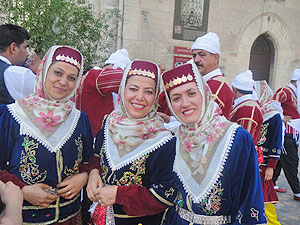 So,
now in the heat of the summer, we have regular
treats of music. For a week before Bastille
Day there is drum music, singing and colorfully-dressed
groups of dancers throughout town. Some
of them resemble whirling dervishes! It
is an impromptu festival of Arabian music. In
the Place de la Mairie I manage to get a photo
of three very glamorous ladies in their finest
garb with smiles that could melt the North Pole. So,
now in the heat of the summer, we have regular
treats of music. For a week before Bastille
Day there is drum music, singing and colorfully-dressed
groups of dancers throughout town. Some
of them resemble whirling dervishes! It
is an impromptu festival of Arabian music. In
the Place de la Mairie I manage to get a photo
of three very glamorous ladies in their finest
garb with smiles that could melt the North Pole.
Also in
the Place de la Mairie they have put up the new
schedule for the summer's festivities called Tempos
d'Été or Rhythms of Summer. Fête
de la Musique is June 21, the Summer Solstice
which is celebrated all over Europe. During
this night the French have what they call une
nuit blanche, which means they stay up all
night until dawn. The anticipation is palpable
and dozens of bands line both sides of the canal. The
city has also closed off our street and Le Place
des Jacobins right in front of the building. A
cool bossa nova jazz band sets up and starts
cranking out very seductive Brazilian music that
is impossible to ignore - being right outside
our windows - so we are transported to
the celebrations and last for hours going from
band to band enjoying a wide variety of songs. We
particularly like a bluegrass band that plays
incredibly good banjo and guitar. The singing
is also terrific except for one minor and endearing
flaw – ze French accent!
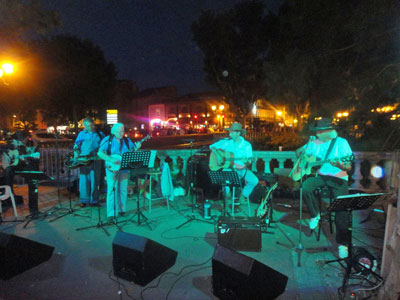
Hearing these
American folk songs sung so beautifully with
a French accent just makes me smile. There
is an enormous love of American country music
here in Narbonne, and we see several bands
that play acoustic music à la USA. Of
course there are lots of French folk singers,
Spanish Flamenco performers and traditional
French torch songs that had been made famous
by Edith Piaf, Charles Trenet and Charles Aznavour
among others. Friends in Toulouse sadly
reported that they had little more than DJ
music in their streets, but I am proud to say
Narbonne was a true festival of live musicians.
Although the
Fête de la Musique is supposed to last
all night, it hasn't done so for the past two
years due to – rain. Around 12:30
AM the raindrops begin to fall and the music
stops completely by 1 AM. However, I'm
sure that the Narbonne cleanup crew doesn't mind. At
the end of every festival they come out in force,
by the dozens, and the mess is gone before the
next day's breakfast baguette seekers are hitting
the pavement.
Our little
chambre d'hotes is in full swing with travelers
making our 300-year old porte d'entrée look
like a revolving door. This year's guests
come from a wide variety of countries and have
varying personalities to match. Early
in June we have serious American hikers who manage
to walk from our city center down the canal chemin
d'halage to Port Nouvelle and back, a 35
kilometer round trip. Not bad for one day. Next
there are university professors from Australia
here to hire a canal boat followed by Canadian
cyclists who arrived from Carcassonne on bicycle
which is is a half hour by car - about 65 kilometers
away. After these serious trekkers we get
a couple from Aberdeen, Scotland on their honeymoon,
a Swiss couple on their babymoon, a geologist
and then a priest who stays to preside over a
wedding. An ex-Foreign Legionnaire searching
for his comrades adds intrigue to our mix of
guests.
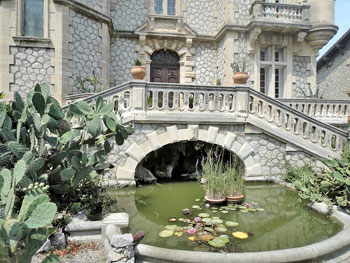 There are
also property seekers sprinkled in the group,
people either looking for a second home in southern
France or an investment. Buying and selling
properties in different parts of the world has
been my passion for many years so I can't help
myself from looking at interesting places available
just for curiosity's sake. This brings
me to pay a visit to a château right on
the edge of Narbonne, along the Canal de la Robine. There are
also property seekers sprinkled in the group,
people either looking for a second home in southern
France or an investment. Buying and selling
properties in different parts of the world has
been my passion for many years so I can't help
myself from looking at interesting places available
just for curiosity's sake. This brings
me to pay a visit to a château right on
the edge of Narbonne, along the Canal de la Robine.
Château
Mandirac used
to be a wine domaine but is now a private home
nestled in the Narbonnais paysage. It
has a fascinating history. Around the end of
the 19th century the French winemakers experienced
a devastating plague on their vines. The
phylloxera bug brought down most vignerons
in France, and many people were ruined. Anyone
who could produce wine made a fortune as the
price went skyrocketing due to the great scarcity. However,
some of the producers along the Canal de la
Robine were able to literally drown the bugs
by flooding their fields with water from the
canal. They became the nouveau riche
of the region, and about a dozen of them used
their new-found wealth to build châteaus. Château
Mandirac is one of these. It is a classic
château with large gardens, a small grotto,
curving staircases and colorful tiled floors. It
has turrets and marble fireplaces and stained
glass windows. All the things one might
expect from a château. I particularly
like the size as it isn't enormous, just big
enough for a modern family to enjoy without
being slaves to the upkeep. The owners
have lived in it for 13 years and are moving
into another château in Narbonne that
they will renovate to suit their lifestyle
with grown children. It is selling for
over one million euros. The photos show
a little of its charm and beauty.
Places such
as Château Mandirac are known as patrimoine in
France. Patrimoine means 'heritage', and
the French certainly have plenty of it. While
Narbonne has its share, it could have had much
more than it does as it used to be a walled city. For
some 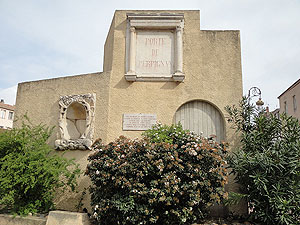 reason
the wall was painstakingly demolished over a
period of three years in the late 19th century
along with several Roman temples. The walls
were six meters high in some places and around
three feet thick. The stones were carved
and portals opened to the roads which led to
various nearby cities: Beziers, Perpignan, Carcassonne,
etc. A vestige still remains of the Porte
de Perpignan along with its decorative niches. Around
2,000 of the ornate stones have been preserved
in the Musée Lapidaire in the gothic church
of Notre-Dame de Lamourguier. There you can see
bas-reliefs, columns, corner stones and statues. After
the collections in Rome, it is one of the most
important collections of decorative stones in
the world. reason
the wall was painstakingly demolished over a
period of three years in the late 19th century
along with several Roman temples. The walls
were six meters high in some places and around
three feet thick. The stones were carved
and portals opened to the roads which led to
various nearby cities: Beziers, Perpignan, Carcassonne,
etc. A vestige still remains of the Porte
de Perpignan along with its decorative niches. Around
2,000 of the ornate stones have been preserved
in the Musée Lapidaire in the gothic church
of Notre-Dame de Lamourguier. There you can see
bas-reliefs, columns, corner stones and statues. After
the collections in Rome, it is one of the most
important collections of decorative stones in
the world.
Patrimoine is
also very visible in the buildings actively in
use today. I took a few photos of sculptures
and masonry for an idea of Narbonne's patrimoine. On
Rue Jean Jaurès near the Place de la Mairie
muscled Roman men hold up a balcony on a recently
renovated hotel – their faces are contorted
in anguish. Whether it is from their Atlas
strain or a more esoteric pain is unclear. The
building is beautiful with an enormous carved
double door set with cast iron half-moon grilles. An
engraving says it was built in the 17th century. Another
building shows a Poseidon type of character flanked
by two Minervas. It hasn't been cleaned
in a while, but the figures still show good detail. The
good Docteur Ferroul is a hero in Narbonne, having
led the revolt of the vignerons about 100 years
ago, and his image is immortalized next to the
Palais de Travaille a classic example of Art
Déco architecture.
  
Pillar
of a Roman man Statues
of 'Poseidon' and two Minervas Docteur
Ferroul
Mysterious heads
above curved doorways frequently decorate many
entryways in Narbonne. I took photos of
some of the better preserved ones. Bearded
men are popular as you can see from the photos. The
Occitan cross is also found everywhere and comes
in many styles - there is one just outside the
Museum of Contemporary Art. In the Salon
des Consuls, located in the Place de la Mairie,
there is a wonderful brass wall sculpture that
I like the most. A figure comes straight
out of the wall, blowing a trumpet in a siren
call from the Aude River. Water figures
are popular in Narbonne's patrimoine. Perhaps
because the river used to run through the city,
water made it an important trading center before
the River Aude silted in and the galleon ships
could no longer sail into the city center. Nostradamus
in Century 3, Quatrain 88 predicted Narbonne's
population would reach one million. Interesting
that he didn't foresee the silting of the Aude.
  
Sculpted
heads adorn buildings Occitan
cross at the Museum Brass
trumpeter
July in
France brings us two of the biggest annual events
in the country: Bastille Day and the Tour
de France. The Tour captures our attention
for three weeks and, as they normally pass through
the Languedoc-Roussillon, we usually go to see
them at some point. This year we
went to the small village of Aigues-Vives. The
weather was actually chilly and a little overcast. Having
brought a picnic we decide to get a bottle of
red wine to go along with the food and warm us
up a little. Thus we walk into a small
grocery store laden with several shelves of locally
produced wines. I choose a deep ruby Grenache
and ask the clerk if it is one she would recommend. She
replies she doesn't drink wine but that the maker
is the mayor of Aigues-Vives. The
manager and a customer tell us the same thing
with their classic French shrugs. They
know who makes the wine, but haven't tasted the
wine themselves. Who knows? Well,
we bought it and can say it went well with the
food.
Back to
the Tour, we settle in our beach chairs to have
lunch and people watch. The crowd starts
assembling at noon and swells to full size, a
few hundred, around 2 PM. Two to three
hours for about sixty seconds of thrill. First la
caravane zooms by. It includes a baguette
covered car promoting a bakery, trucks of Vittel
water sprayers, Carrefour disco dancers throwing
out red, white and blue polka dot hats matching
the shirts on the cyclists, Haribo candy makers
tossing out chewy samples of jelly beans, and
a tire sponsor with enormous statues of cyclists
that bear down on the crowd below it as it races
through the street at around 65 miles per hour. Once
in a while a truck halts to sell the crowd official
Tour souvenirs which all bear the bright yellow
color of the winning jersey. I still have
my yellow umbrella from three Tours ago.
Once the
caravane is through, the helicopters start hovering
above our heads, and we know the stars of the
show are about to come through. We can
hear a collective roar coming from down the street
as the tête de la course appears. Suddenly
they are upon us, and we are all yelling encouragement
whether we want to or not – the excitement
is too infectious. The cyclists pump furiously
just inches past us, and then they are gone. One
straggler comes a second later and the crowd
gives him their last – and biggest - roar
of encouragement. We take an audio/video
of the experience this time. It's all of
56 seconds, and we've watched it several times
ourselves just to relive the excitement. I
think you will enjoy it as well. Much as
a château or a bas-relief, the Tour is
also part of our patrimoine. [Click here to
see the author's video of the Tour]
Bastille Day
is always exciting and this year was no exception. The
City of Narbonne does a good job in setting up
impressive fireworks at the Parc d'Exposition. Thousands
of Narbonnais and tourists alike make the ten
minute walk from city center to ooh and aah at
the 15 minute fireworks display.
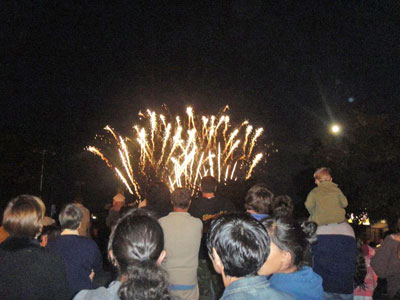
Fireworks
on Bastille Day draw a crowd in Narbonne
July is
a hard month to match for excitement but August
will outdo July with the Charles Trenet Festival,
Les Jours d'Antan and many other events. The
tourists are swelling the town numbers more than
ever, and there is hardly any French heard in
the streets as tourists are always talking to
each other, shouting to their children or looking
at menus and talking about the various dishes
on offer. English, German and Spanish are
the most popular languages but I am hearing a
lot more Scandinavian and seeing more Japanese
this year than last year. A new Forester
hotel resort is being built on the canal de La
Robine just on the edge of town. The little
electric rental boats are buzzing up and down
the canal next to the large hire boats that float
lazily toward the next lock, their occupants
sampling some of the local rosé. A
couple of impressive private yachts have decided
to stay awhile and, as ex-boat owners, we can't
help but drool a little bit over their pristine
decks. The City of Narbonne is planning
a massive multi-million euro overhaul on our
side of the Canal de la Robine, la rive droite,
to make it more pedestrian friendly and accessible
to the public. It looks just fine to me
now, but the future is beckoning for more glamour
and fun. They are anticipating nothing
less than total success and so am I.
Wine
Notes
Recently we
attended a grand degustation at a restaurant
called Les Souquets that is nestled in
the heart of La Clape, Narbonne's pristine reserve
of nature. Surrounded by cliffs and trees
we tried some excellent, and unusual, local wines.
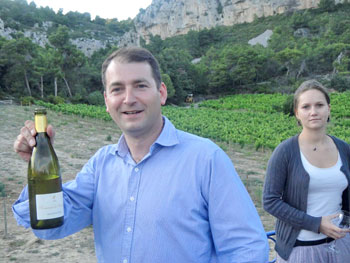 The tasting
was hosted by our friend Charles Husson, a professional
vendor and connoisseur of wines of our region. Two
white wines stood out among the others. What
was very special about these wines is they are
100% Bourboulenc, which is a very old varietal
and rumored to have Greek origins. It's normally
used for blending but Domaine de Simonet's Christophe
Barbier gives the Bourboulenc it's own spotlight
with 100% Bourboulenc wines that are very impressive
without the usual pretentious prices. This
is especially interesting as it is also classified
as a 'Bio Wine' which is the French equivalent
of 'Organic Wine'. The tasting
was hosted by our friend Charles Husson, a professional
vendor and connoisseur of wines of our region. Two
white wines stood out among the others. What
was very special about these wines is they are
100% Bourboulenc, which is a very old varietal
and rumored to have Greek origins. It's normally
used for blending but Domaine de Simonet's Christophe
Barbier gives the Bourboulenc it's own spotlight
with 100% Bourboulenc wines that are very impressive
without the usual pretentious prices. This
is especially interesting as it is also classified
as a 'Bio Wine' which is the French equivalent
of 'Organic Wine'.
The Domaine
de Simonet 2008 Bourboulenc blanc, is clean crisp
and unoaked. It is a great all around wine
for any occasion and doesn't need a particular
food group to blossom on your pallet. A bottle
retails for €6.90.
The second
wine is Domaine de Simonet's 2006 Les Terres
Salées blanc, again 100% Bourboulenc aged
in oak for six months. It is a deeper white with
flowery nose, nice acidity and lovely vanilla
finish that is often found in well oaked wines. It
retails for €12.50 a bottle. As members
of a wine club we can get a 20% discount which
makes these very reasonably priced yet fabulous
wines.
Domaine de
Simonet is a small domaine in La Clape near Narbonne
next to the sea. The wine gets its unusual flavor
from the salty earth that is often "spritzed" by
Mediterranean sea due to the famous high winds
of the area.
French
Vocabulary
La
Voile Rouge – The Red Sail
Cantines – Casual
dining restaurants
Moules
frites – Mussels
and French fries
Resto – Short
for Restaurant, the French love to truncate words
La
vie est belle – Life is Beautiful
Ados – short
for adolescents
Poubelles -
trash
Platane – a
tree most common in France along the Canal du
Midi, Narbonne and in Provence - known
as sycamores in North American and plane trees
in England.
Une
nuit blanche – a
white night – no one sleeps
Porte
d'entrée – entry
door
Chemin
d'halage -
towpath along the canal where the draft horses
use to walk while pulling a boat
Paysage -
countryside
Vignerons -
winemakers
Les
Terres Salées -
the salty earth
Patrimoine -
heritage
La
caravane – parade
Tête
de la course – leader
of the pack
La
rive droite – the
right bank as opposed to la rive gauche which
means the left bank of a river or canal.
Les
Souquets – old
vine branches that have been dried out and
are used for grilling food.
La
Clape – Occitan
for 'pile of stones'.
"If you wish to visit France On Your Own, click here
FranceOnYourOwn.com
For
additional information about living in or visiting
Narbonne
by
land or canal boat, or for a lovely bed & breakfast
stay with the O'Neill's
[http://www.narbonnegites.com]
contact marlaneoneill@hotmail.com.
[Photo
credits: Marlane O'Neill 2011. All
rights reserved.
Mouse
over photos for additional descriptions.]

|



